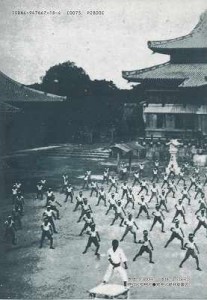

KARATE-DO KOBUDO KIHON CHOSA HOKOKUSHO
kinawa-ken Kyōikuchō Bunka-ka: Karate-dō Kobudō no Kihon Chōsa Hōkokusho Hōkokusho [Basic Research Report of Karate and Kobudō]. Okinawa-ken Kyōiku Iinkai, Naha 1995/97. 179 pp. 26cm. The work is written in Japanese and out-of-print. It has a large number of photos depicting masters, kata, equipment etc. It contains the program of martial arts performed on occasion of the investiture mission in 1867. I translated the contents for you, see below.
Table of Contents
Chapter 1: Overview of the “Basic Research Report of Karate and Kobudō“
- 1. About the “Basic Research Report of Karate and Kobudō” and the necessity for the conservation of documents
- 2. Implementation guidelines of the “Basic Research Report of Karate and Kobudō“
- 3. Commissioning entity
- 4. Criteria for selection of the researchers
- 5. Researchers
- 6. Secretariat
Chapter 2: The Karate-dō of Okinawa
- 1. The Historical Progress of Okinawa Karate-dō
- (1). Introduction
- (2). Weapons and armor found in in the historic ruins
- (3). The beginning of Karate-dō
- (4). The occurrence of various school
- 2. The training of mind and body in Karate-dō
- (1). The objectives of Karate-dō
- (2). philosophical consideration on the “Heart (kokoro) of Karate-dō
- 3. Training Methods
- (1). Training equipment and beneficial training with them
- (2). Kakete (Kakie) and Kote-kitae
- (3). Tanren Kata
- 4. The Pedigree of Okinawa Karate
- (1). The system of Shuri-te
- (2). The system of Naha-te
- (3). The system of Uechi-ryū
- (4). Others
- 5. Popularization and development of Karate, domestic and overseas
- (1). Okinawa Karate-dō and the sport of Karate
- (2). Traditional Karate of Okinawas in the age of globalization
Chapter 3: Ryūkyū Kobudō
- 1. The historical progress of Ryūkyū Kobudō
- (1). Introduction
- (2). They road towards Kobudō
- 2. About the equipment
- (1). Introduction
- (2). Application and technique of the various devices (by Nakamoto Masahiro)
- 3. Training methods (Tanren-hō)
- (1). Introduction
- (2) The most important training methods6
- 4. The Pedigree of Ryūkyū Kobudō
- (1). Kobudō and Kobujutsu of Ryūkyū
- (2). The History of Ryūkyū Kobudō
- (3). Origin, masters and Kata of Ryūkyū Kobudō
- (4) The Pedigree of Ryūkyū Kobudō
- (5). Present condition and pedigree of Ryūkyū Kobudō
- 5. Spread and development of Ryūkyū Kobudō
Chapter 4: Mura-bō
- Introduction
- 1. Folk festivals and Mura-bō
- 2. Ryūkyū Kobudō (Bōjutsu) and Mura-bō
- 3. Comparison of Mura-bō and the Bōjutsu of Kobudō (-jutsu)
- 4 . Distribution of Mura-bō
- 5. Synopsis
Chapter 5: traditional karate as a designated cultural heritage and issues related to it
- 1. What is a cultural heritage
- 2. Historical characteristics of traditional karate
- 3. Designation of traditional Karate as a cultural heritage and juridical questions
- Tabular survey of the different schools
- Photographs of the Kata, training methods, and training equipment of the various schools
- Investigation of the distribution of Mura-bō by districts
- Historical data: The program of 3-6-9 various arts (1867)
© 2013 – 2017, Andreas Quast. All rights reserved.
